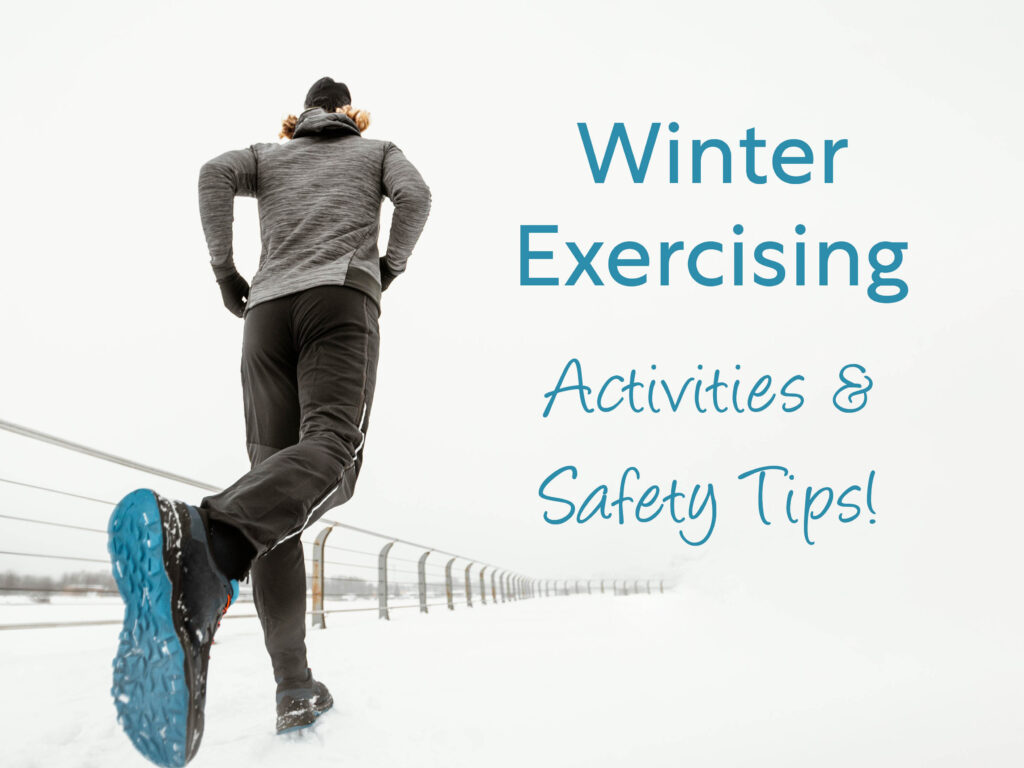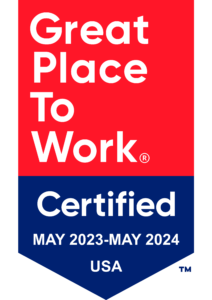Make Healthy Changes in a Healthy Way
Stay Fit and Stay Safe this Winter!
Staying active in the winter can be difficult, but it’s often easy to come up with excuses to not exercise — there’s snow on the ground, it’s too wet to run, you don’t have a gym membership. Luckily, there is so much you can do in the winter months to stay active besides running or going to a gym. Whether your winter has rain, snow, or sunshine in the forecast, here are some ideas for different workouts and physical activities that you can do during the winter, along with some great safety tips!
Indoor Activities for Winter
When there’s snow on the ground and the wind is blowing so hard it knocks you over or you feel the chill through your bones, physical activity might not even cross your mind. Don’t let the brisk weather discourage you! There are many different activities that you can do indoors to stay active when you can’t bear the cold.
Bodyweight Exercises
No equipment needed for these! Not everyone has access to a gym or has free weights in their home, which is why bodyweight exercises are so handy. All you need is — you guessed it — your body! Doing simple exercises like squats, pushups, lunges, or burpees can keep you active and get your heart rate up. If you want to add a little extra challenge, try out some resistance bands. These are great for when you want to challenge yourself and build more muscle without having to worry about heavy weights.
Yoga, Pilates, and Barre
Yoga is a great way to unwind after a stressful day, or it’s a great way to get your day started. It’s not just for stretching either – you can get your heart pumping with indoor yoga just like you can with a run (but with less risk of slipping on an icy sidewalk). It’s an ideal indoor exercise to focus on cardio, strength, and flexibility. With options from beginner to advanced, there is something out there that everyone can enjoy.
Pilates is similar to yoga in the sense that it builds strength and flexibility. This is often used to help strengthen the core and build stability and flexibility. It also prioritizes quality over quantity; instead of doing repeated moves, each movement focuses on the breath and precision of the exercise, which helps you become more stable. The stability isn’t just physical — it can improve your mental balance, too!
Barre is a more intense version of yoga and Pilates. This focuses on small, targeted movements with high repetitions and light weights or resistance bands to create low-impact, high-intensity movements. It is a full-body workout that you can modify or enhance practically any way you’d like to make it easier or more of a challenge.
Boxing and Kickboxing
Got an old punching bag in your garage or basement? Now’s a great time to put it to use. If you don’t have a bag, you can still go through the motions and get a good workout in. Throw some punches, work on your dodging skills and movements, and gain experience. The trick here is to focus on technique; if you aren’t sure exactly what movements to do, go online! There are lots and lots of videos available to walk you through the steps. If you’ve got a local boxing studio, you could also sign up for in-person lessons.
Tai Chi
This low impact exercise originated from ancient China and has become very popular over the years. It may just look like slow-motion martial arts, but it is so much more. These slow, intricate movements and deep breathing techniques help you clear your head by reducing stress and anxiety, and work to improve your balance. Until you try it, you may not realize how hard it can be to go slow.

Outdoor Activities for Winter
Don’t want to be cooped up all day inside? Want some fresh air? When the temperature is safe and bearable, there are many different ways you can remain physically active outside! Since winter is often the time when you don’t get enough of a lot of needed vitamins and minerals, exercising outdoors can have the added benefit of soaking up some Vitamin D. You can also check out BioActive Nutrients and SolutionsRx, our lines of vitamins that we offer to help give you that extra boost if you aren’t thrilled with the idea of outdoor winter activities. We have a FREE vitamin club for kiddos, too!
Walking, Jogging, or Running
Taking a brisk walk, or a short jog or run around the neighborhood can keep you on your toes while also allowing you to experience the beauty of winter close-up. Some people love doing these cardio activities year-round, which is great! If you are living in an area that doesn’t get snow during the winter, it can still be great for you to do these activities. Grab a friend and get going!
Shoveling Snow
Although this may not sound like the most enjoyable thing to do…as anyone who lives in a snowy climate knows, it’s sort of a necessity. Whether you grab a shovel or a snow blower, this is a great chance to get some physical activity in. Since you already have to do it, you might as well have fun with it! If you have kids, throwing shoveled snow into a pile gives a great opportunity for the kiddos to have some outdoor time, too by making a snow fort, tunnels, or creating a snowman.
Ice Skating
This is such a fun activity to do during the winter and is perfect for the whole family. Many ice rinks offer walkers or guides for inexperienced skaters to use to help them get around the rink without worrying about falling. This is perfect for little ones or anyone in the family who has minimal ice-skating experience.
Snowboarding, Skiing, and Sledding
Snowboarding and skiing are great for those seeking a thrilling outdoor winter experience and both are great for burning calories! So, while you are having fun, you are also getting in a workout.
Sledding is the perfect opportunity to get friends and family together. There are lots of different options for sledding, from hill size and location to the type of sled you use, that everyone will enjoy. It’s great for getting active and having fun!
Safety Tips
Since winter weather can be dangerous, there are some precautions you should take into consideration before heading outside. Even if you are opting for an indoor activity, it’s important to understand the safest way to exercise.
Monitor the Weather
If you plan on doing an outdoor activity during the winter, make sure you keep an eye on the weather. This is important so you can figure out what to wear on your outdoor adventure. It’s also helpful in planning ahead for what activities you plan on doing and for how long. Make sure you are aware of slick roads or sidewalks before going for a jog and be sure you are wearing the proper attire, including your shoes.
Stay Warm
Ensuring you have the proper gear to head outside during the winter is crucial. Snow pants, coat, hat and gloves are a must with the option for multiple layers. The best way to layer is to start with a moisture-wicking fabric (much like those used in sportswear), then add a layer of fleece and finally a thin waterproof layer.
Hypothermia is no joke and can have serious consequences. Keep an eye out for these symptoms to help identify if someone is becoming hypothermic.
- Lack of coordination
- Mental confusion
- Slowed reactions
- Slurred speech
- Cold feet and hands
- Shivering
- Sleepiness
Stay Hydrated
Just like during the summer, it is very important to stay hydrated – especially when you are exercising. Whether you are working out inside or hitting the slopes outside, you should have water with you to keep you hydrated and energized to keep going. A great product to give you extra hydration is Biolyte. Stop at our pharmacy to grab a bottle today!
Stretching
Before and after any physical activity, it’s important to stretch to make sure your muscles are warmed up. It’s especially important during the winter so your muscles don’t cramp anytime during or after your workout is complete. Dynamic stretching is best to do before your workout. These types of stretches are used to get your body moving and ready for your workout. Some examples include high knees, jumping jacks, walking lunges, and leg swings. Then there’s static stretching, which is best for after your workout is complete. These stretches are still-standing movements to really focus on getting your muscles a nice cool down. Hamstring stretches, ab stretches, triceps stretches, and quad stretches are just a few examples of these post-workout cool down moves.
With these great activity ideas and safety tips, you’re ready to take on your winter fitness journey. Get up and get going, and don’t forget to have fun!
Sources:
https://www.heart.org/en/healthy-living/fitness/getting-active/how-to-stay-active-in-cold-weather
https://www.everydayhealth.com/healthy-living-photos/ways-to-stay-active-in-the-winter.aspx
https://health.clevelandclinic.org/how-to-stay-active-outside-when-the-weather-gets-colder/
https://greatist.com/fitness/20-awesome-indoor-workouts-try-winters-over
https://www.cdc.gov/nccdphp/dnpao/features/stay-active-this-winter/index.html
- « Previous Page
- 1
- …
- 18
- 19
- 20
- 21
- 22
- …
- 62
- Next Page »
